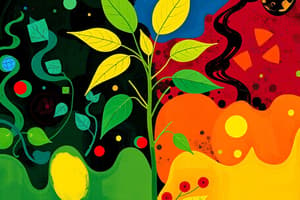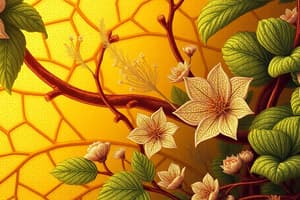Podcast
Questions and Answers
How do all plants produce food?
How do all plants produce food?
Photosynthesis
Are there any plants that are unicellular? Prokaryotic?
Are there any plants that are unicellular? Prokaryotic?
False (B)
Plants are different from algae mostly because they live on land.
Plants are different from algae mostly because they live on land.
False (B)
What structures in plants gather light (usually)?
What structures in plants gather light (usually)?
What structures in plants help them raise up above the soil?
What structures in plants help them raise up above the soil?
What structures in plants anchor them to the ground and absorb water and nutrients?
What structures in plants anchor them to the ground and absorb water and nutrients?
What fungal associations do most plant roots have with fungi?
What fungal associations do most plant roots have with fungi?
What do the fungi do for the plant?
What do the fungi do for the plant?
What does the plant do for the fungi?
What does the plant do for the fungi?
What are the small holes on the underside of leaves called?
What are the small holes on the underside of leaves called?
What are the small holes on the underside of leaves used for?
What are the small holes on the underside of leaves used for?
What is the vascular tissue in plants that moves water up from the soil?
What is the vascular tissue in plants that moves water up from the soil?
What is the vascular tissue in plants that moves the products of photosynthesis down from the leaves?
What is the vascular tissue in plants that moves the products of photosynthesis down from the leaves?
What plants are the most familiar bryophytes?
What plants are the most familiar bryophytes?
Bryophytes are the most primitive plants that live on land.
Bryophytes are the most primitive plants that live on land.
What are the two key terrestrial adaptations that mosses show?
What are the two key terrestrial adaptations that mosses show?
What is the waxy covering that all land plants have on their leaves?
What is the waxy covering that all land plants have on their leaves?
What is the function of the waxy covering on the leaves of land plants?
What is the function of the waxy covering on the leaves of land plants?
What are the two main stages in the life cycle of mosses?
What are the two main stages in the life cycle of mosses?
What does the gametophyte generation produce?
What does the gametophyte generation produce?
What term means that there are two distinct generations in plants that are different in their n number?
What term means that there are two distinct generations in plants that are different in their n number?
What does the sporophyte generation of mosses produce?
What does the sporophyte generation of mosses produce?
Ferns are seedless vascular plants.
Ferns are seedless vascular plants.
During what period did ferns dominate the landscape?
During what period did ferns dominate the landscape?
The remains of the old fern swamps are now used as?
The remains of the old fern swamps are now used as?
What term means 'naked seed'?
What term means 'naked seed'?
What two things are gymnosperms missing that angiosperms possess?
What two things are gymnosperms missing that angiosperms possess?
Gymnosperms are better adapted for dry climates because they do not need ______ for reproduction.
Gymnosperms are better adapted for dry climates because they do not need ______ for reproduction.
What term means that a plant keeps its leaves all year?
What term means that a plant keeps its leaves all year?
What are the three major adaptations of seed plants?
What are the three major adaptations of seed plants?
A pollen grain is actually a very small sporophyte generation of the pine tree.
A pollen grain is actually a very small sporophyte generation of the pine tree.
In plants, what is a small packet of food with an embryo inside?
In plants, what is a small packet of food with an embryo inside?
In what ways are we dependent on angiosperms?
In what ways are we dependent on angiosperms?
A ripened ovary containing seeds is a?
A ripened ovary containing seeds is a?
How do fruits help plants and animals?
How do fruits help plants and animals?
What is the main difference between fruits and vegetables?
What is the main difference between fruits and vegetables?
What do fungi do that is so important to our ecosystem?
What do fungi do that is so important to our ecosystem?
Are there any photosynthetic fungi?
Are there any photosynthetic fungi?
How do fungi acquire food?
How do fungi acquire food?
The bodies of most fungi are constructed of structures called?
The bodies of most fungi are constructed of structures called?
An interwoven mat of hyphae is called a?
An interwoven mat of hyphae is called a?
What are the cell walls of fungi composed of?
What are the cell walls of fungi composed of?
How do fungi reproduce?
How do fungi reproduce?
Fungi are important in our production of food.
Fungi are important in our production of food.
What two terms mean that two different species live together and they both benefit?
What two terms mean that two different species live together and they both benefit?
What are mutualistic associations between fungi and algae that grow on rocks?
What are mutualistic associations between fungi and algae that grow on rocks?
What do the fungi provide to the association?
What do the fungi provide to the association?
What do the algae provide to the association?
What do the algae provide to the association?
Spanish moss is a?
Spanish moss is a?
Flashcards are hidden until you start studying
Study Notes
Photosynthesis and Plant Basics
- Plants produce food primarily through photosynthesis.
- Unicellular and prokaryotic plants do not exist; unicellular organisms include bacteria, whereas plants and animals are multicellular.
Plant Structure and Functions
- Leaves are the main structures for gathering light.
- Stems/shoots support plants above the soil.
- Roots anchor plants to the ground, absorbing water and nutrients.
Plant-Fungi Relationships
- Most plant roots form associations with fungi known as mycorrhizae, enhancing nutrient absorption.
- Fungi assist in nutrient uptake while receiving sugars from plants.
Gas Exchange and Vascular Tissues
- Stomata, tiny openings on leaf undersides, facilitate gas exchange.
- Xylem transports water from the soil, while phloem distributes products of photosynthesis.
Bryophytes (Mosses)
- Mosses are the most familiar bryophytes and represent primitive land plants.
- They feature a waxy cuticle to prevent dehydration and retain developing embryos within the maternal gametangium.
Life Cycle of Mosses
- Two main stages: gametophyte (produces gametes) and sporophyte (produces spores).
- The concept of alternation of generations describes the two distinct generations in mosses.
Seedless Vascular Plants
- Ferns are identified as seedless vascular plants and dominated landscapes during the Carboniferous period (290-360 million years ago).
- The remnants of ancient fern swamps have become fossil fuels.
Gymnosperms and Their Adaptations
- "Naked seeds" are referred to as gymnosperms, such as conifers, which have adaptations including non-shelled seeds, pollen, and seed development.
- Gymnosperms lack flowers and seed shells, and they do not require standing water for reproduction.
- Evergreen plants retain leaves year-round.
Characteristics of Seed Plants
- Key adaptations of seed plants compared to mosses and ferns include non-shelled seeds, pollen, and advanced seed development.
Reproduction in Plants
- A pollen grain is a small gametophyte generation of a pine tree.
- Seeds consist of a food packet with an embryo.
- Angiosperms are vital for food and clothing sources.
Fruits and Their Functions
- A ripened ovary containing seeds is classified as a fruit, which protects seeds and facilitates their dispersal.
- The main distinction between fruits and vegetables is that fruits contain seeds.
Fungi in Ecosystems
- Fungi play an essential role in decomposing material, recycling nutrients in ecosystems.
- No fungi are photosynthetic; they acquire food by digesting material externally through secreted enzymes.
- Fungal structures consist of hyphae, forming a mycelium, and their cell walls are made of chitin.
Fungal Reproduction and Symbiosis
- Fungi reproduce asexually by releasing spores.
- Mutual symbiosis describes the beneficial coexistence of different species.
- Lichens are mutualistic associations between fungi and algae, often found growing on rocks.
Contributions of Fungi and Algae
- In the lichen association, fungi provide decomposition, whereas algae contribute oxygen and plankton.
Studying That Suits You
Use AI to generate personalized quizzes and flashcards to suit your learning preferences.




